Global Sustainability Issue
VerifiedAdded on 2023/06/11
|11
|2762
|142
AI Summary
This article discusses the major sustainability issue of food security and its impact on the environment, economy, and society. It explores the economic, social, and ethical solutions to increase worldwide food security in the midst of climate change. The article also covers the effects of food security on businesses and the opportunities and threats it poses. References are provided for further reading.
Contribute Materials
Your contribution can guide someone’s learning journey. Share your
documents today.
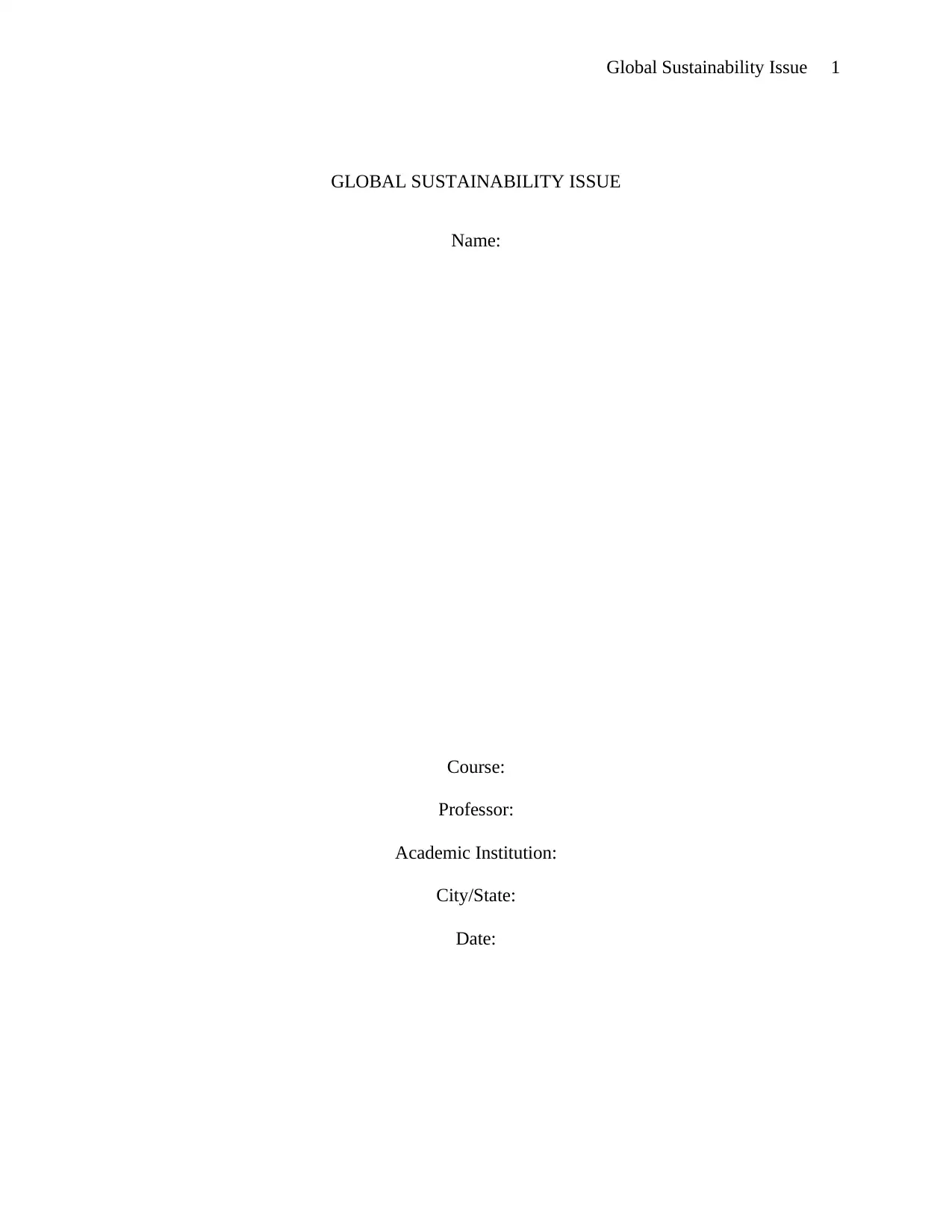
Global Sustainability Issue 1
GLOBAL SUSTAINABILITY ISSUE
Name:
Course:
Professor:
Academic Institution:
City/State:
Date:
GLOBAL SUSTAINABILITY ISSUE
Name:
Course:
Professor:
Academic Institution:
City/State:
Date:
Secure Best Marks with AI Grader
Need help grading? Try our AI Grader for instant feedback on your assignments.
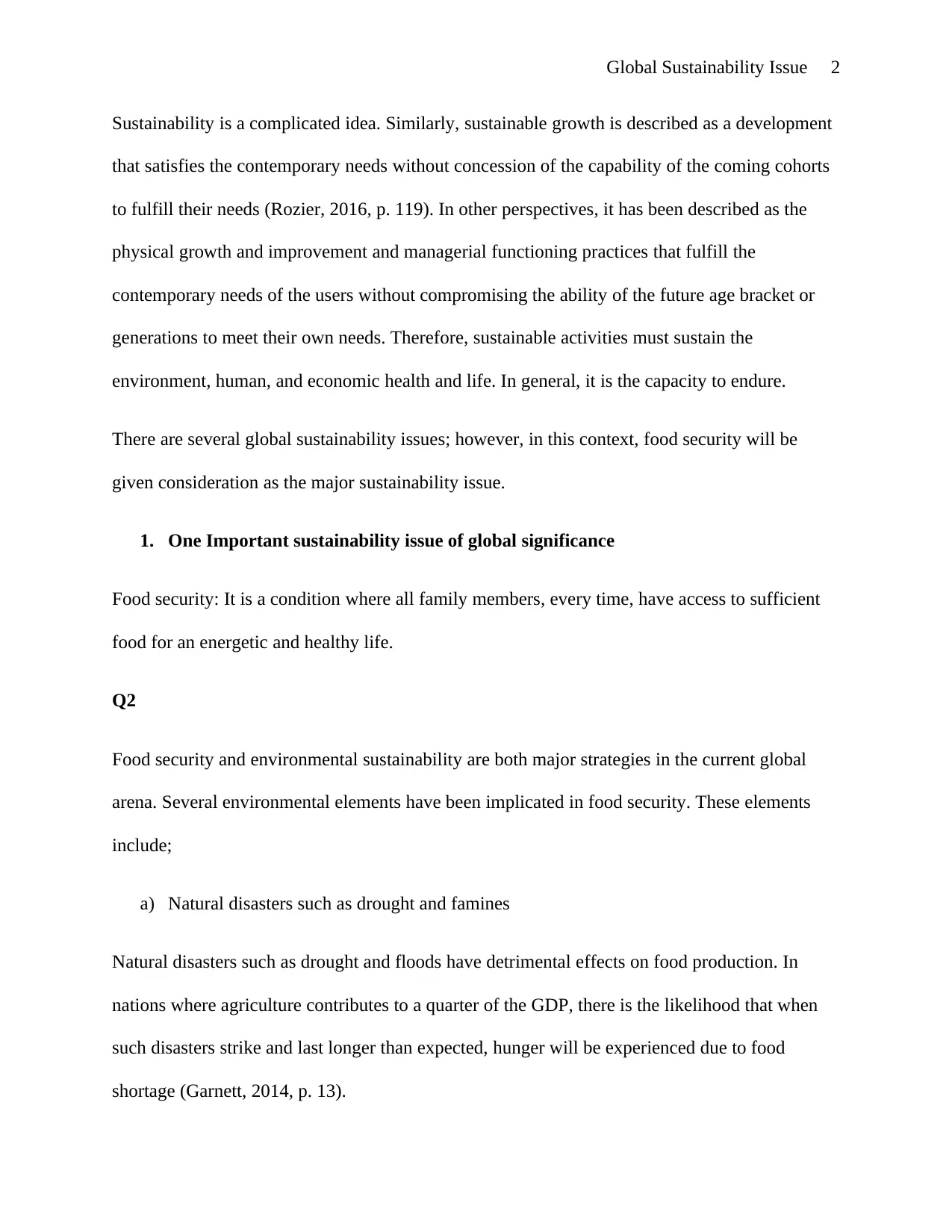
Global Sustainability Issue 2
Sustainability is a complicated idea. Similarly, sustainable growth is described as a development
that satisfies the contemporary needs without concession of the capability of the coming cohorts
to fulfill their needs (Rozier, 2016, p. 119). In other perspectives, it has been described as the
physical growth and improvement and managerial functioning practices that fulfill the
contemporary needs of the users without compromising the ability of the future age bracket or
generations to meet their own needs. Therefore, sustainable activities must sustain the
environment, human, and economic health and life. In general, it is the capacity to endure.
There are several global sustainability issues; however, in this context, food security will be
given consideration as the major sustainability issue.
1. One Important sustainability issue of global significance
Food security: It is a condition where all family members, every time, have access to sufficient
food for an energetic and healthy life.
Q2
Food security and environmental sustainability are both major strategies in the current global
arena. Several environmental elements have been implicated in food security. These elements
include;
a) Natural disasters such as drought and famines
Natural disasters such as drought and floods have detrimental effects on food production. In
nations where agriculture contributes to a quarter of the GDP, there is the likelihood that when
such disasters strike and last longer than expected, hunger will be experienced due to food
shortage (Garnett, 2014, p. 13).
Sustainability is a complicated idea. Similarly, sustainable growth is described as a development
that satisfies the contemporary needs without concession of the capability of the coming cohorts
to fulfill their needs (Rozier, 2016, p. 119). In other perspectives, it has been described as the
physical growth and improvement and managerial functioning practices that fulfill the
contemporary needs of the users without compromising the ability of the future age bracket or
generations to meet their own needs. Therefore, sustainable activities must sustain the
environment, human, and economic health and life. In general, it is the capacity to endure.
There are several global sustainability issues; however, in this context, food security will be
given consideration as the major sustainability issue.
1. One Important sustainability issue of global significance
Food security: It is a condition where all family members, every time, have access to sufficient
food for an energetic and healthy life.
Q2
Food security and environmental sustainability are both major strategies in the current global
arena. Several environmental elements have been implicated in food security. These elements
include;
a) Natural disasters such as drought and famines
Natural disasters such as drought and floods have detrimental effects on food production. In
nations where agriculture contributes to a quarter of the GDP, there is the likelihood that when
such disasters strike and last longer than expected, hunger will be experienced due to food
shortage (Garnett, 2014, p. 13).
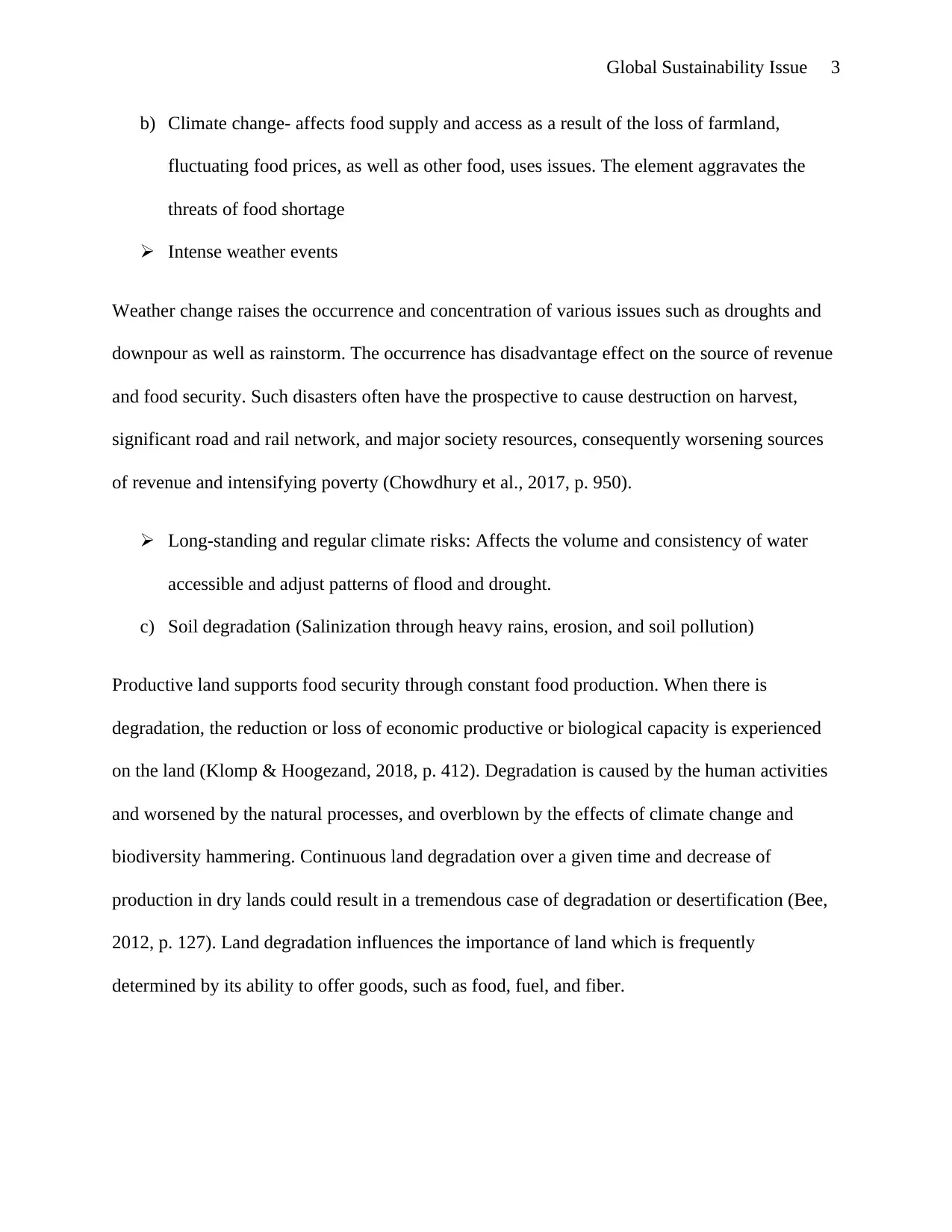
Global Sustainability Issue 3
b) Climate change- affects food supply and access as a result of the loss of farmland,
fluctuating food prices, as well as other food, uses issues. The element aggravates the
threats of food shortage
Intense weather events
Weather change raises the occurrence and concentration of various issues such as droughts and
downpour as well as rainstorm. The occurrence has disadvantage effect on the source of revenue
and food security. Such disasters often have the prospective to cause destruction on harvest,
significant road and rail network, and major society resources, consequently worsening sources
of revenue and intensifying poverty (Chowdhury et al., 2017, p. 950).
Long-standing and regular climate risks: Affects the volume and consistency of water
accessible and adjust patterns of flood and drought.
c) Soil degradation (Salinization through heavy rains, erosion, and soil pollution)
Productive land supports food security through constant food production. When there is
degradation, the reduction or loss of economic productive or biological capacity is experienced
on the land (Klomp & Hoogezand, 2018, p. 412). Degradation is caused by the human activities
and worsened by the natural processes, and overblown by the effects of climate change and
biodiversity hammering. Continuous land degradation over a given time and decrease of
production in dry lands could result in a tremendous case of degradation or desertification (Bee,
2012, p. 127). Land degradation influences the importance of land which is frequently
determined by its ability to offer goods, such as food, fuel, and fiber.
b) Climate change- affects food supply and access as a result of the loss of farmland,
fluctuating food prices, as well as other food, uses issues. The element aggravates the
threats of food shortage
Intense weather events
Weather change raises the occurrence and concentration of various issues such as droughts and
downpour as well as rainstorm. The occurrence has disadvantage effect on the source of revenue
and food security. Such disasters often have the prospective to cause destruction on harvest,
significant road and rail network, and major society resources, consequently worsening sources
of revenue and intensifying poverty (Chowdhury et al., 2017, p. 950).
Long-standing and regular climate risks: Affects the volume and consistency of water
accessible and adjust patterns of flood and drought.
c) Soil degradation (Salinization through heavy rains, erosion, and soil pollution)
Productive land supports food security through constant food production. When there is
degradation, the reduction or loss of economic productive or biological capacity is experienced
on the land (Klomp & Hoogezand, 2018, p. 412). Degradation is caused by the human activities
and worsened by the natural processes, and overblown by the effects of climate change and
biodiversity hammering. Continuous land degradation over a given time and decrease of
production in dry lands could result in a tremendous case of degradation or desertification (Bee,
2012, p. 127). Land degradation influences the importance of land which is frequently
determined by its ability to offer goods, such as food, fuel, and fiber.
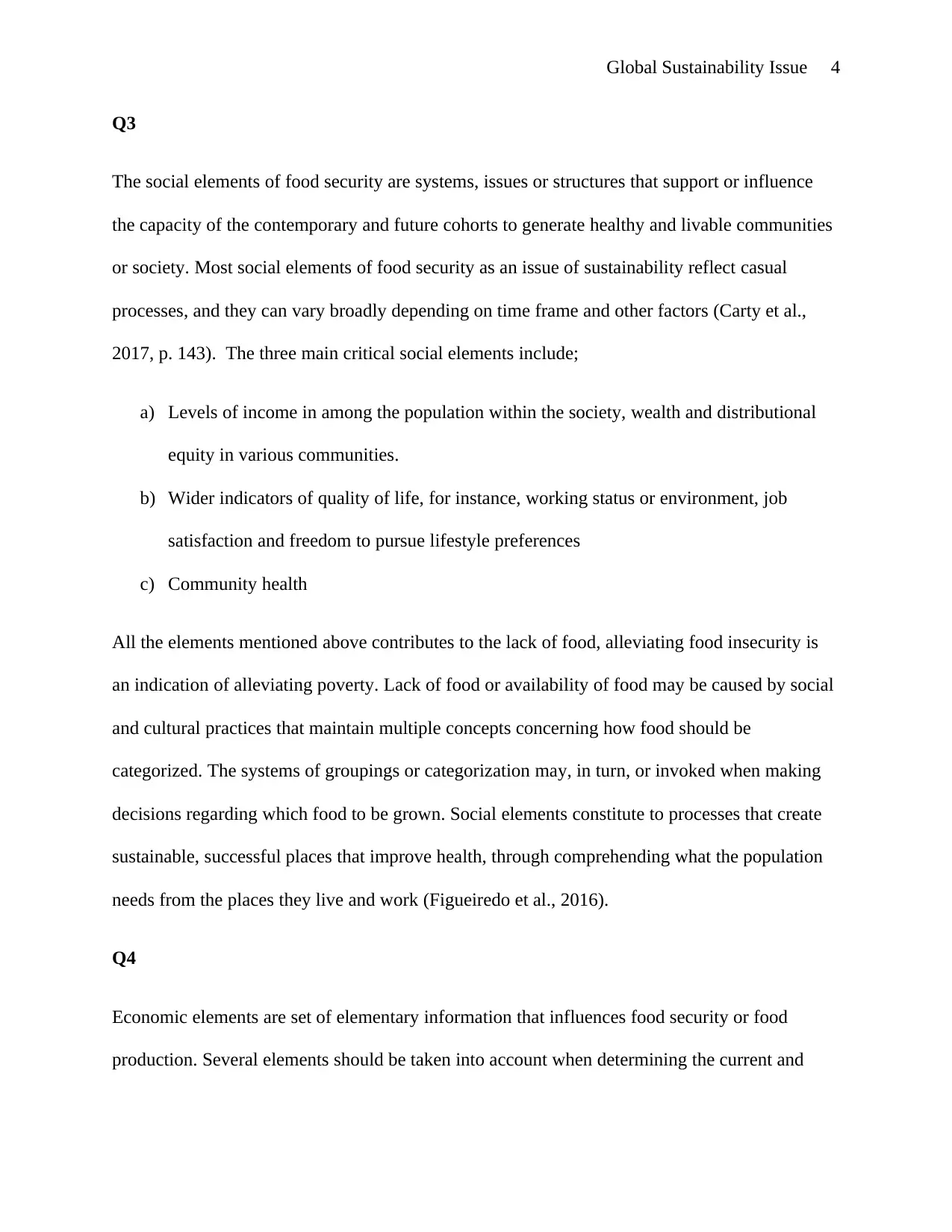
Global Sustainability Issue 4
Q3
The social elements of food security are systems, issues or structures that support or influence
the capacity of the contemporary and future cohorts to generate healthy and livable communities
or society. Most social elements of food security as an issue of sustainability reflect casual
processes, and they can vary broadly depending on time frame and other factors (Carty et al.,
2017, p. 143). The three main critical social elements include;
a) Levels of income in among the population within the society, wealth and distributional
equity in various communities.
b) Wider indicators of quality of life, for instance, working status or environment, job
satisfaction and freedom to pursue lifestyle preferences
c) Community health
All the elements mentioned above contributes to the lack of food, alleviating food insecurity is
an indication of alleviating poverty. Lack of food or availability of food may be caused by social
and cultural practices that maintain multiple concepts concerning how food should be
categorized. The systems of groupings or categorization may, in turn, or invoked when making
decisions regarding which food to be grown. Social elements constitute to processes that create
sustainable, successful places that improve health, through comprehending what the population
needs from the places they live and work (Figueiredo et al., 2016).
Q4
Economic elements are set of elementary information that influences food security or food
production. Several elements should be taken into account when determining the current and
Q3
The social elements of food security are systems, issues or structures that support or influence
the capacity of the contemporary and future cohorts to generate healthy and livable communities
or society. Most social elements of food security as an issue of sustainability reflect casual
processes, and they can vary broadly depending on time frame and other factors (Carty et al.,
2017, p. 143). The three main critical social elements include;
a) Levels of income in among the population within the society, wealth and distributional
equity in various communities.
b) Wider indicators of quality of life, for instance, working status or environment, job
satisfaction and freedom to pursue lifestyle preferences
c) Community health
All the elements mentioned above contributes to the lack of food, alleviating food insecurity is
an indication of alleviating poverty. Lack of food or availability of food may be caused by social
and cultural practices that maintain multiple concepts concerning how food should be
categorized. The systems of groupings or categorization may, in turn, or invoked when making
decisions regarding which food to be grown. Social elements constitute to processes that create
sustainable, successful places that improve health, through comprehending what the population
needs from the places they live and work (Figueiredo et al., 2016).
Q4
Economic elements are set of elementary information that influences food security or food
production. Several elements should be taken into account when determining the current and
Secure Best Marks with AI Grader
Need help grading? Try our AI Grader for instant feedback on your assignments.
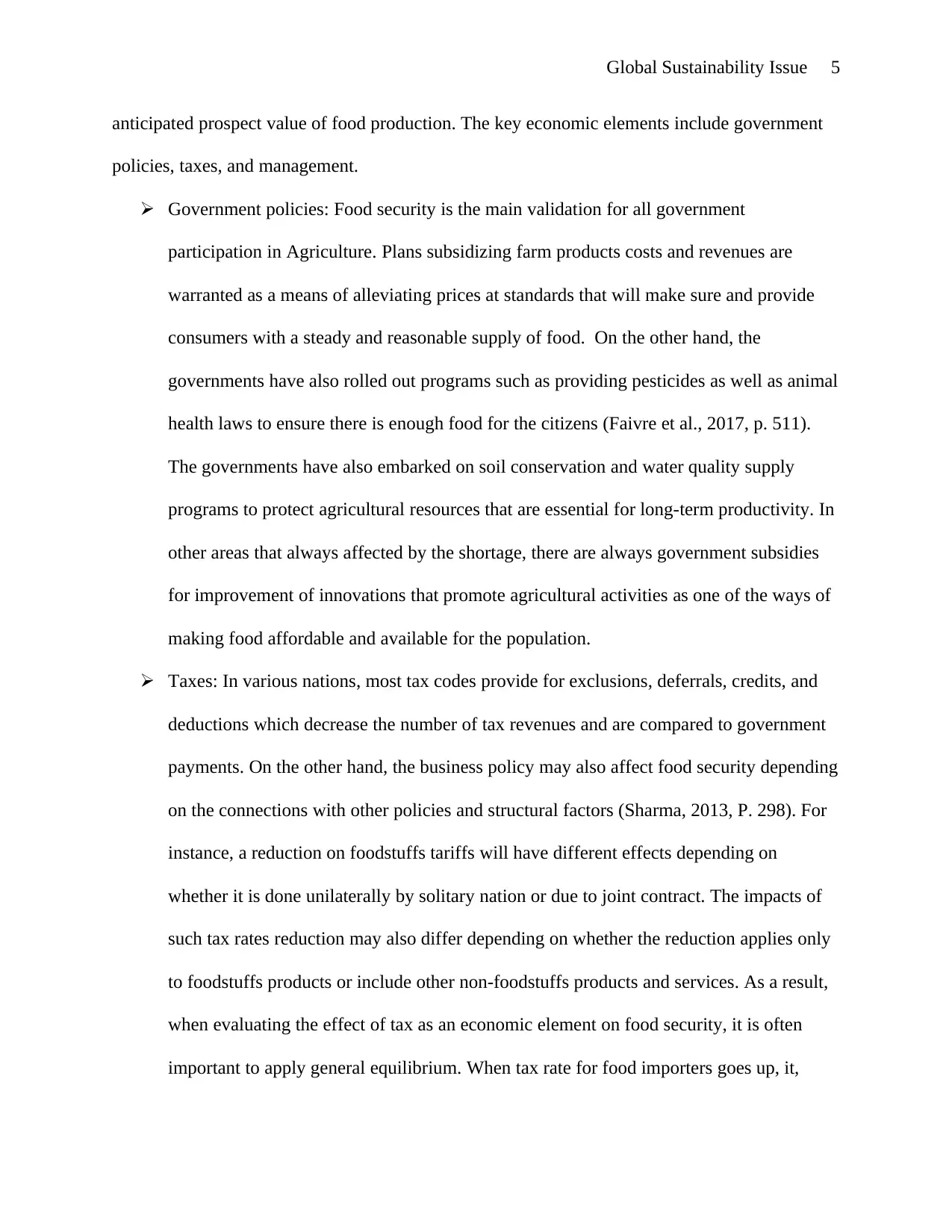
Global Sustainability Issue 5
anticipated prospect value of food production. The key economic elements include government
policies, taxes, and management.
Government policies: Food security is the main validation for all government
participation in Agriculture. Plans subsidizing farm products costs and revenues are
warranted as a means of alleviating prices at standards that will make sure and provide
consumers with a steady and reasonable supply of food. On the other hand, the
governments have also rolled out programs such as providing pesticides as well as animal
health laws to ensure there is enough food for the citizens (Faivre et al., 2017, p. 511).
The governments have also embarked on soil conservation and water quality supply
programs to protect agricultural resources that are essential for long-term productivity. In
other areas that always affected by the shortage, there are always government subsidies
for improvement of innovations that promote agricultural activities as one of the ways of
making food affordable and available for the population.
Taxes: In various nations, most tax codes provide for exclusions, deferrals, credits, and
deductions which decrease the number of tax revenues and are compared to government
payments. On the other hand, the business policy may also affect food security depending
on the connections with other policies and structural factors (Sharma, 2013, P. 298). For
instance, a reduction on foodstuffs tariffs will have different effects depending on
whether it is done unilaterally by solitary nation or due to joint contract. The impacts of
such tax rates reduction may also differ depending on whether the reduction applies only
to foodstuffs products or include other non-foodstuffs products and services. As a result,
when evaluating the effect of tax as an economic element on food security, it is often
important to apply general equilibrium. When tax rate for food importers goes up, it,
anticipated prospect value of food production. The key economic elements include government
policies, taxes, and management.
Government policies: Food security is the main validation for all government
participation in Agriculture. Plans subsidizing farm products costs and revenues are
warranted as a means of alleviating prices at standards that will make sure and provide
consumers with a steady and reasonable supply of food. On the other hand, the
governments have also rolled out programs such as providing pesticides as well as animal
health laws to ensure there is enough food for the citizens (Faivre et al., 2017, p. 511).
The governments have also embarked on soil conservation and water quality supply
programs to protect agricultural resources that are essential for long-term productivity. In
other areas that always affected by the shortage, there are always government subsidies
for improvement of innovations that promote agricultural activities as one of the ways of
making food affordable and available for the population.
Taxes: In various nations, most tax codes provide for exclusions, deferrals, credits, and
deductions which decrease the number of tax revenues and are compared to government
payments. On the other hand, the business policy may also affect food security depending
on the connections with other policies and structural factors (Sharma, 2013, P. 298). For
instance, a reduction on foodstuffs tariffs will have different effects depending on
whether it is done unilaterally by solitary nation or due to joint contract. The impacts of
such tax rates reduction may also differ depending on whether the reduction applies only
to foodstuffs products or include other non-foodstuffs products and services. As a result,
when evaluating the effect of tax as an economic element on food security, it is often
important to apply general equilibrium. When tax rate for food importers goes up, it,
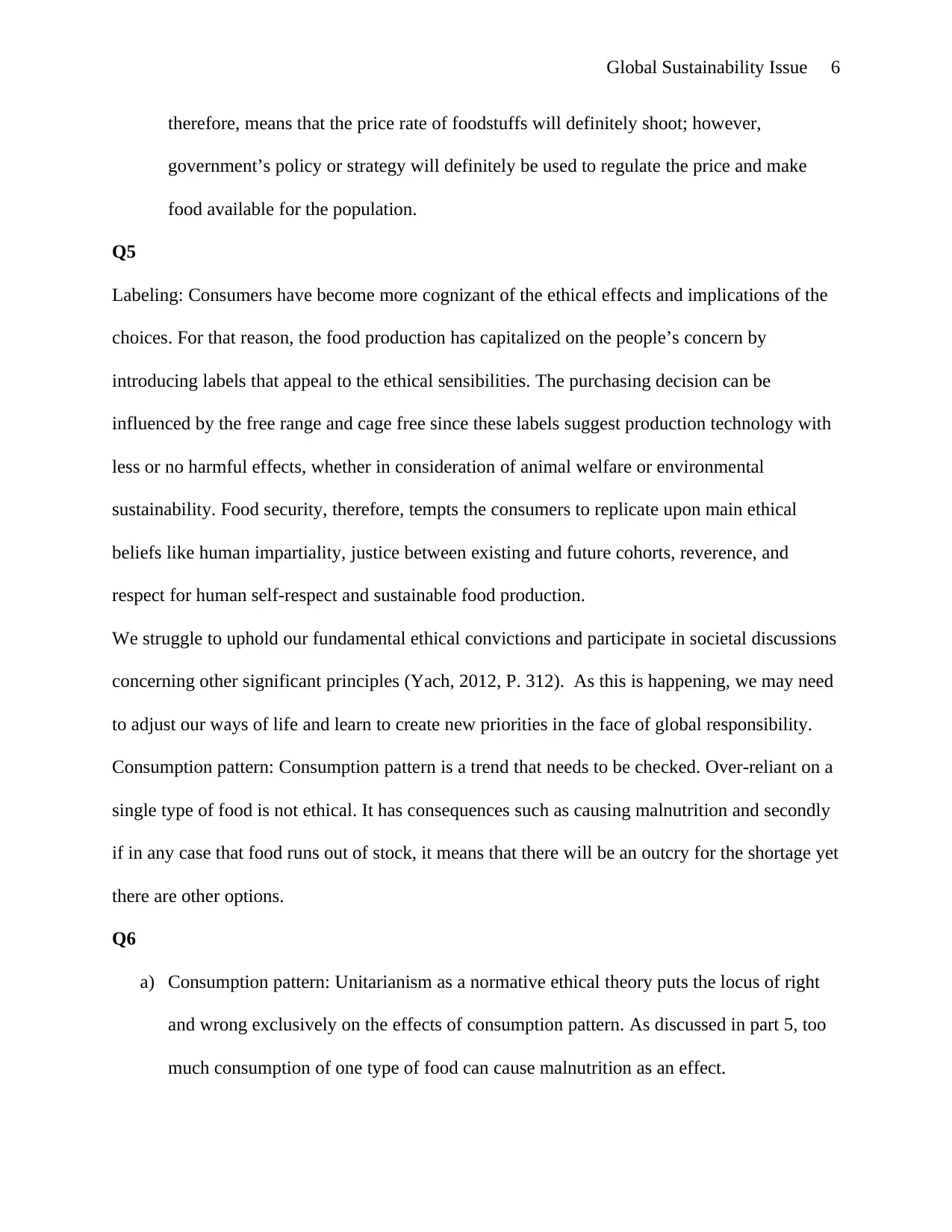
Global Sustainability Issue 6
therefore, means that the price rate of foodstuffs will definitely shoot; however,
government’s policy or strategy will definitely be used to regulate the price and make
food available for the population.
Q5
Labeling: Consumers have become more cognizant of the ethical effects and implications of the
choices. For that reason, the food production has capitalized on the people’s concern by
introducing labels that appeal to the ethical sensibilities. The purchasing decision can be
influenced by the free range and cage free since these labels suggest production technology with
less or no harmful effects, whether in consideration of animal welfare or environmental
sustainability. Food security, therefore, tempts the consumers to replicate upon main ethical
beliefs like human impartiality, justice between existing and future cohorts, reverence, and
respect for human self-respect and sustainable food production.
We struggle to uphold our fundamental ethical convictions and participate in societal discussions
concerning other significant principles (Yach, 2012, P. 312). As this is happening, we may need
to adjust our ways of life and learn to create new priorities in the face of global responsibility.
Consumption pattern: Consumption pattern is a trend that needs to be checked. Over-reliant on a
single type of food is not ethical. It has consequences such as causing malnutrition and secondly
if in any case that food runs out of stock, it means that there will be an outcry for the shortage yet
there are other options.
Q6
a) Consumption pattern: Unitarianism as a normative ethical theory puts the locus of right
and wrong exclusively on the effects of consumption pattern. As discussed in part 5, too
much consumption of one type of food can cause malnutrition as an effect.
therefore, means that the price rate of foodstuffs will definitely shoot; however,
government’s policy or strategy will definitely be used to regulate the price and make
food available for the population.
Q5
Labeling: Consumers have become more cognizant of the ethical effects and implications of the
choices. For that reason, the food production has capitalized on the people’s concern by
introducing labels that appeal to the ethical sensibilities. The purchasing decision can be
influenced by the free range and cage free since these labels suggest production technology with
less or no harmful effects, whether in consideration of animal welfare or environmental
sustainability. Food security, therefore, tempts the consumers to replicate upon main ethical
beliefs like human impartiality, justice between existing and future cohorts, reverence, and
respect for human self-respect and sustainable food production.
We struggle to uphold our fundamental ethical convictions and participate in societal discussions
concerning other significant principles (Yach, 2012, P. 312). As this is happening, we may need
to adjust our ways of life and learn to create new priorities in the face of global responsibility.
Consumption pattern: Consumption pattern is a trend that needs to be checked. Over-reliant on a
single type of food is not ethical. It has consequences such as causing malnutrition and secondly
if in any case that food runs out of stock, it means that there will be an outcry for the shortage yet
there are other options.
Q6
a) Consumption pattern: Unitarianism as a normative ethical theory puts the locus of right
and wrong exclusively on the effects of consumption pattern. As discussed in part 5, too
much consumption of one type of food can cause malnutrition as an effect.
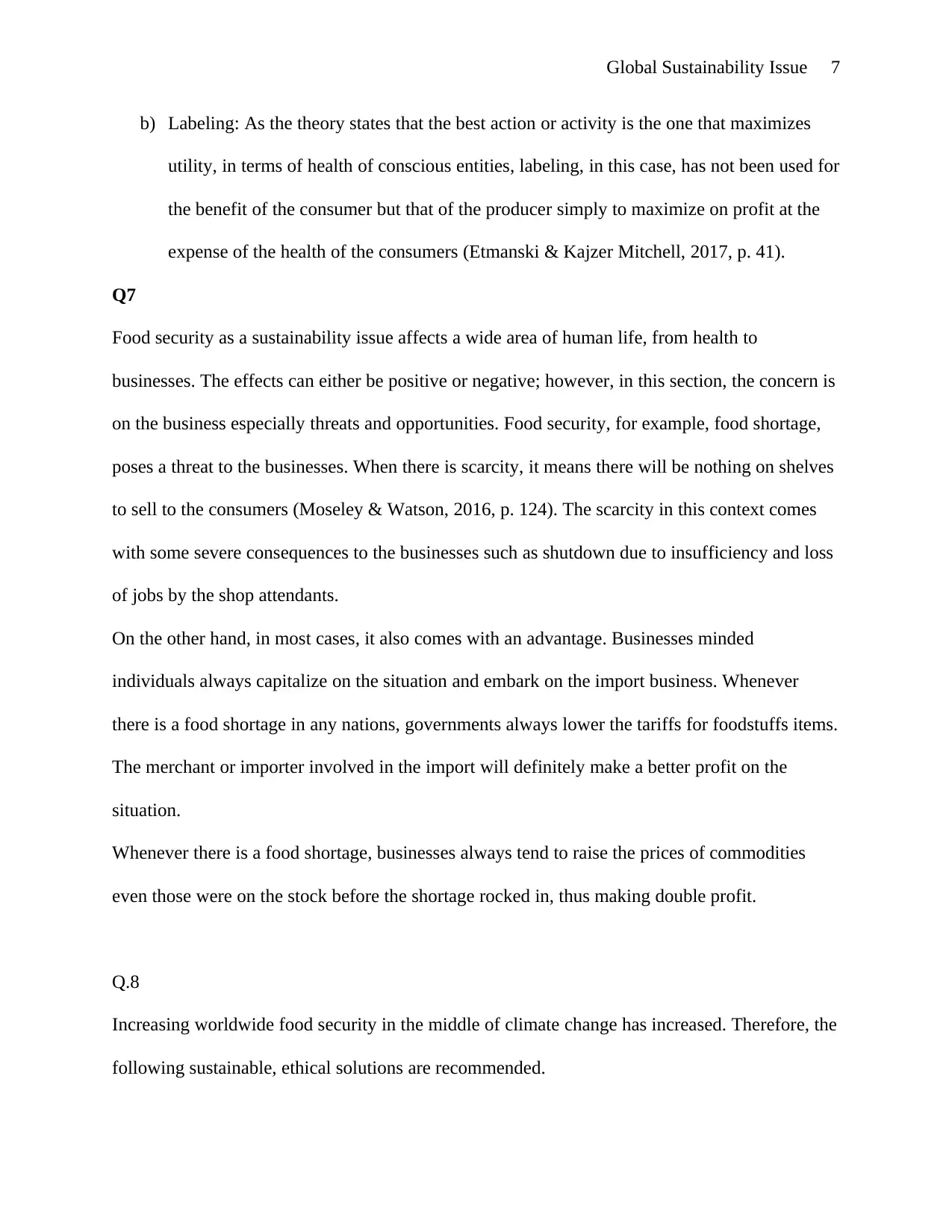
Global Sustainability Issue 7
b) Labeling: As the theory states that the best action or activity is the one that maximizes
utility, in terms of health of conscious entities, labeling, in this case, has not been used for
the benefit of the consumer but that of the producer simply to maximize on profit at the
expense of the health of the consumers (Etmanski & Kajzer Mitchell, 2017, p. 41).
Q7
Food security as a sustainability issue affects a wide area of human life, from health to
businesses. The effects can either be positive or negative; however, in this section, the concern is
on the business especially threats and opportunities. Food security, for example, food shortage,
poses a threat to the businesses. When there is scarcity, it means there will be nothing on shelves
to sell to the consumers (Moseley & Watson, 2016, p. 124). The scarcity in this context comes
with some severe consequences to the businesses such as shutdown due to insufficiency and loss
of jobs by the shop attendants.
On the other hand, in most cases, it also comes with an advantage. Businesses minded
individuals always capitalize on the situation and embark on the import business. Whenever
there is a food shortage in any nations, governments always lower the tariffs for foodstuffs items.
The merchant or importer involved in the import will definitely make a better profit on the
situation.
Whenever there is a food shortage, businesses always tend to raise the prices of commodities
even those were on the stock before the shortage rocked in, thus making double profit.
Q.8
Increasing worldwide food security in the middle of climate change has increased. Therefore, the
following sustainable, ethical solutions are recommended.
b) Labeling: As the theory states that the best action or activity is the one that maximizes
utility, in terms of health of conscious entities, labeling, in this case, has not been used for
the benefit of the consumer but that of the producer simply to maximize on profit at the
expense of the health of the consumers (Etmanski & Kajzer Mitchell, 2017, p. 41).
Q7
Food security as a sustainability issue affects a wide area of human life, from health to
businesses. The effects can either be positive or negative; however, in this section, the concern is
on the business especially threats and opportunities. Food security, for example, food shortage,
poses a threat to the businesses. When there is scarcity, it means there will be nothing on shelves
to sell to the consumers (Moseley & Watson, 2016, p. 124). The scarcity in this context comes
with some severe consequences to the businesses such as shutdown due to insufficiency and loss
of jobs by the shop attendants.
On the other hand, in most cases, it also comes with an advantage. Businesses minded
individuals always capitalize on the situation and embark on the import business. Whenever
there is a food shortage in any nations, governments always lower the tariffs for foodstuffs items.
The merchant or importer involved in the import will definitely make a better profit on the
situation.
Whenever there is a food shortage, businesses always tend to raise the prices of commodities
even those were on the stock before the shortage rocked in, thus making double profit.
Q.8
Increasing worldwide food security in the middle of climate change has increased. Therefore, the
following sustainable, ethical solutions are recommended.
Paraphrase This Document
Need a fresh take? Get an instant paraphrase of this document with our AI Paraphraser
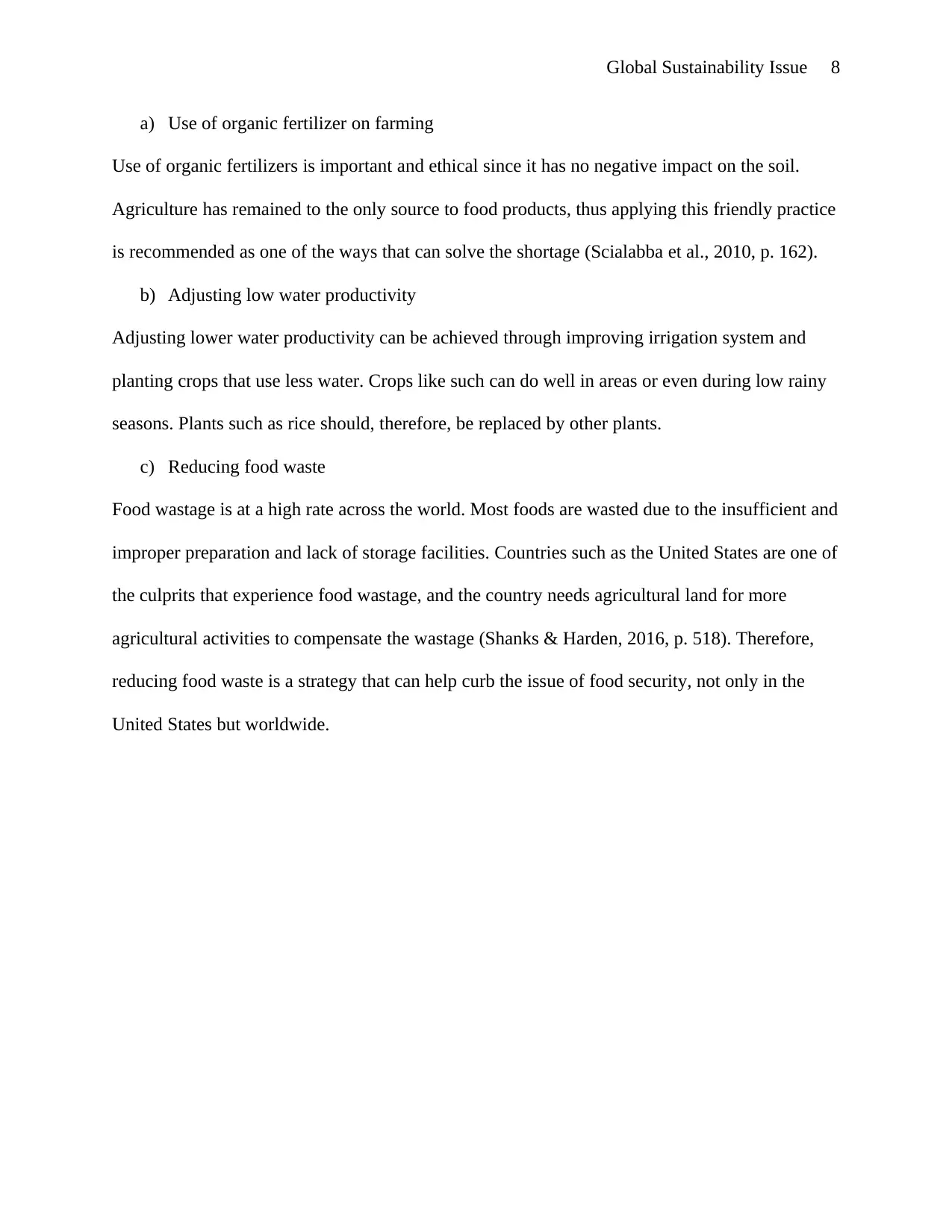
Global Sustainability Issue 8
a) Use of organic fertilizer on farming
Use of organic fertilizers is important and ethical since it has no negative impact on the soil.
Agriculture has remained to the only source to food products, thus applying this friendly practice
is recommended as one of the ways that can solve the shortage (Scialabba et al., 2010, p. 162).
b) Adjusting low water productivity
Adjusting lower water productivity can be achieved through improving irrigation system and
planting crops that use less water. Crops like such can do well in areas or even during low rainy
seasons. Plants such as rice should, therefore, be replaced by other plants.
c) Reducing food waste
Food wastage is at a high rate across the world. Most foods are wasted due to the insufficient and
improper preparation and lack of storage facilities. Countries such as the United States are one of
the culprits that experience food wastage, and the country needs agricultural land for more
agricultural activities to compensate the wastage (Shanks & Harden, 2016, p. 518). Therefore,
reducing food waste is a strategy that can help curb the issue of food security, not only in the
United States but worldwide.
a) Use of organic fertilizer on farming
Use of organic fertilizers is important and ethical since it has no negative impact on the soil.
Agriculture has remained to the only source to food products, thus applying this friendly practice
is recommended as one of the ways that can solve the shortage (Scialabba et al., 2010, p. 162).
b) Adjusting low water productivity
Adjusting lower water productivity can be achieved through improving irrigation system and
planting crops that use less water. Crops like such can do well in areas or even during low rainy
seasons. Plants such as rice should, therefore, be replaced by other plants.
c) Reducing food waste
Food wastage is at a high rate across the world. Most foods are wasted due to the insufficient and
improper preparation and lack of storage facilities. Countries such as the United States are one of
the culprits that experience food wastage, and the country needs agricultural land for more
agricultural activities to compensate the wastage (Shanks & Harden, 2016, p. 518). Therefore,
reducing food waste is a strategy that can help curb the issue of food security, not only in the
United States but worldwide.
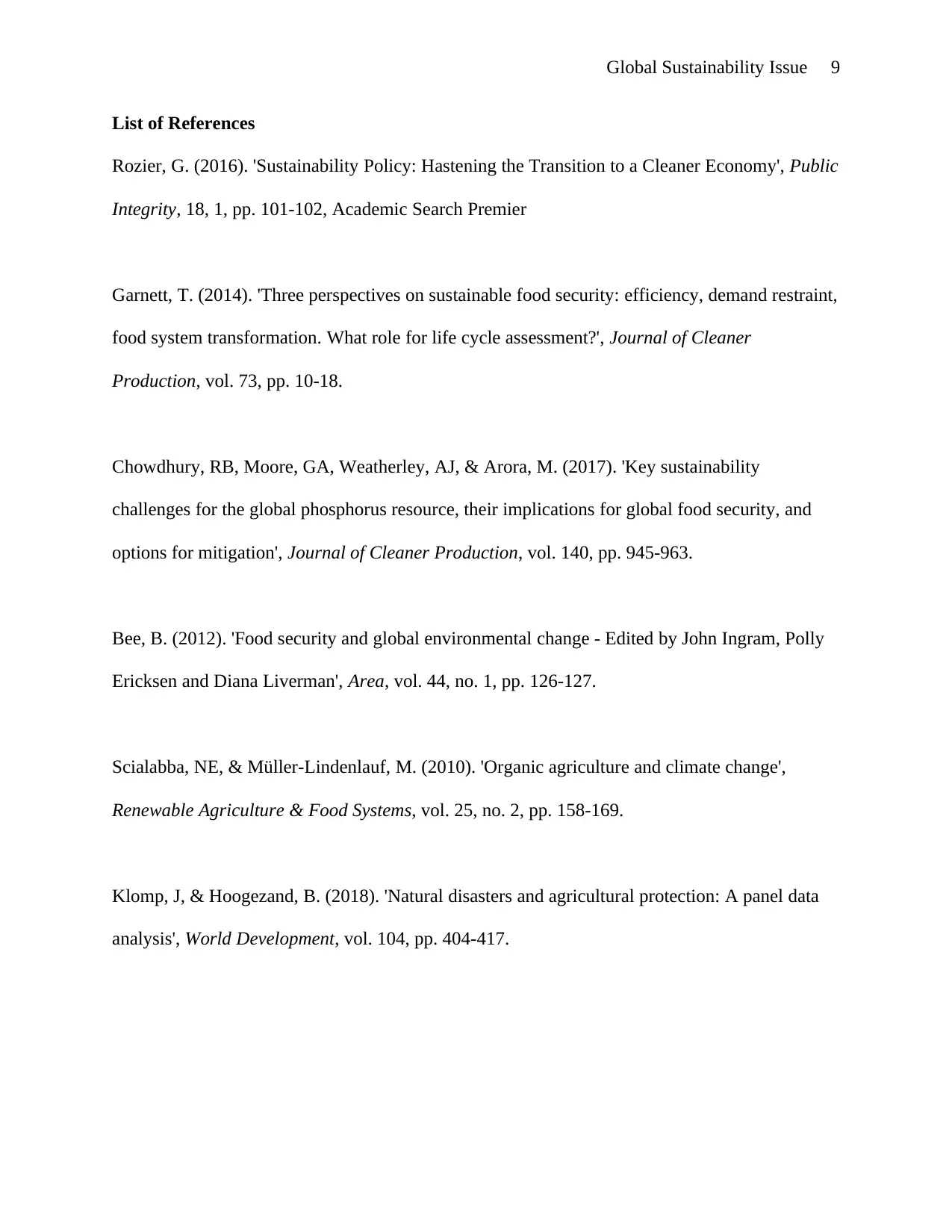
Global Sustainability Issue 9
List of References
Rozier, G. (2016). 'Sustainability Policy: Hastening the Transition to a Cleaner Economy', Public
Integrity, 18, 1, pp. 101-102, Academic Search Premier
Garnett, T. (2014). 'Three perspectives on sustainable food security: efficiency, demand restraint,
food system transformation. What role for life cycle assessment?', Journal of Cleaner
Production, vol. 73, pp. 10-18.
Chowdhury, RB, Moore, GA, Weatherley, AJ, & Arora, M. (2017). 'Key sustainability
challenges for the global phosphorus resource, their implications for global food security, and
options for mitigation', Journal of Cleaner Production, vol. 140, pp. 945-963.
Bee, B. (2012). 'Food security and global environmental change - Edited by John Ingram, Polly
Ericksen and Diana Liverman', Area, vol. 44, no. 1, pp. 126-127.
Scialabba, NE, & Müller-Lindenlauf, M. (2010). 'Organic agriculture and climate change',
Renewable Agriculture & Food Systems, vol. 25, no. 2, pp. 158-169.
Klomp, J, & Hoogezand, B. (2018). 'Natural disasters and agricultural protection: A panel data
analysis', World Development, vol. 104, pp. 404-417.
List of References
Rozier, G. (2016). 'Sustainability Policy: Hastening the Transition to a Cleaner Economy', Public
Integrity, 18, 1, pp. 101-102, Academic Search Premier
Garnett, T. (2014). 'Three perspectives on sustainable food security: efficiency, demand restraint,
food system transformation. What role for life cycle assessment?', Journal of Cleaner
Production, vol. 73, pp. 10-18.
Chowdhury, RB, Moore, GA, Weatherley, AJ, & Arora, M. (2017). 'Key sustainability
challenges for the global phosphorus resource, their implications for global food security, and
options for mitigation', Journal of Cleaner Production, vol. 140, pp. 945-963.
Bee, B. (2012). 'Food security and global environmental change - Edited by John Ingram, Polly
Ericksen and Diana Liverman', Area, vol. 44, no. 1, pp. 126-127.
Scialabba, NE, & Müller-Lindenlauf, M. (2010). 'Organic agriculture and climate change',
Renewable Agriculture & Food Systems, vol. 25, no. 2, pp. 158-169.
Klomp, J, & Hoogezand, B. (2018). 'Natural disasters and agricultural protection: A panel data
analysis', World Development, vol. 104, pp. 404-417.
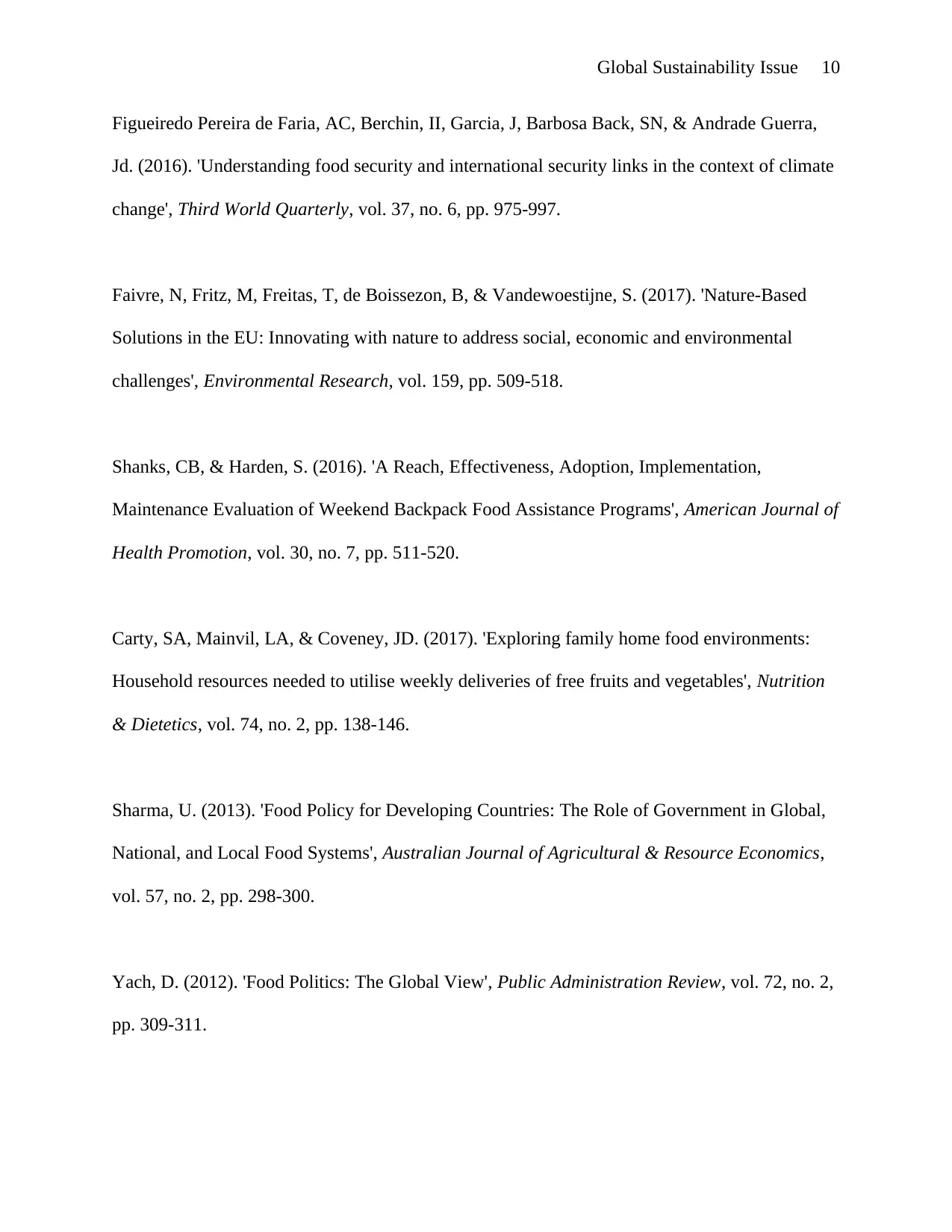
Global Sustainability Issue 10
Figueiredo Pereira de Faria, AC, Berchin, II, Garcia, J, Barbosa Back, SN, & Andrade Guerra,
Jd. (2016). 'Understanding food security and international security links in the context of climate
change', Third World Quarterly, vol. 37, no. 6, pp. 975-997.
Faivre, N, Fritz, M, Freitas, T, de Boissezon, B, & Vandewoestijne, S. (2017). 'Nature-Based
Solutions in the EU: Innovating with nature to address social, economic and environmental
challenges', Environmental Research, vol. 159, pp. 509-518.
Shanks, CB, & Harden, S. (2016). 'A Reach, Effectiveness, Adoption, Implementation,
Maintenance Evaluation of Weekend Backpack Food Assistance Programs', American Journal of
Health Promotion, vol. 30, no. 7, pp. 511-520.
Carty, SA, Mainvil, LA, & Coveney, JD. (2017). 'Exploring family home food environments:
Household resources needed to utilise weekly deliveries of free fruits and vegetables', Nutrition
& Dietetics, vol. 74, no. 2, pp. 138-146.
Sharma, U. (2013). 'Food Policy for Developing Countries: The Role of Government in Global,
National, and Local Food Systems', Australian Journal of Agricultural & Resource Economics,
vol. 57, no. 2, pp. 298-300.
Yach, D. (2012). 'Food Politics: The Global View', Public Administration Review, vol. 72, no. 2,
pp. 309-311.
Figueiredo Pereira de Faria, AC, Berchin, II, Garcia, J, Barbosa Back, SN, & Andrade Guerra,
Jd. (2016). 'Understanding food security and international security links in the context of climate
change', Third World Quarterly, vol. 37, no. 6, pp. 975-997.
Faivre, N, Fritz, M, Freitas, T, de Boissezon, B, & Vandewoestijne, S. (2017). 'Nature-Based
Solutions in the EU: Innovating with nature to address social, economic and environmental
challenges', Environmental Research, vol. 159, pp. 509-518.
Shanks, CB, & Harden, S. (2016). 'A Reach, Effectiveness, Adoption, Implementation,
Maintenance Evaluation of Weekend Backpack Food Assistance Programs', American Journal of
Health Promotion, vol. 30, no. 7, pp. 511-520.
Carty, SA, Mainvil, LA, & Coveney, JD. (2017). 'Exploring family home food environments:
Household resources needed to utilise weekly deliveries of free fruits and vegetables', Nutrition
& Dietetics, vol. 74, no. 2, pp. 138-146.
Sharma, U. (2013). 'Food Policy for Developing Countries: The Role of Government in Global,
National, and Local Food Systems', Australian Journal of Agricultural & Resource Economics,
vol. 57, no. 2, pp. 298-300.
Yach, D. (2012). 'Food Politics: The Global View', Public Administration Review, vol. 72, no. 2,
pp. 309-311.
Secure Best Marks with AI Grader
Need help grading? Try our AI Grader for instant feedback on your assignments.
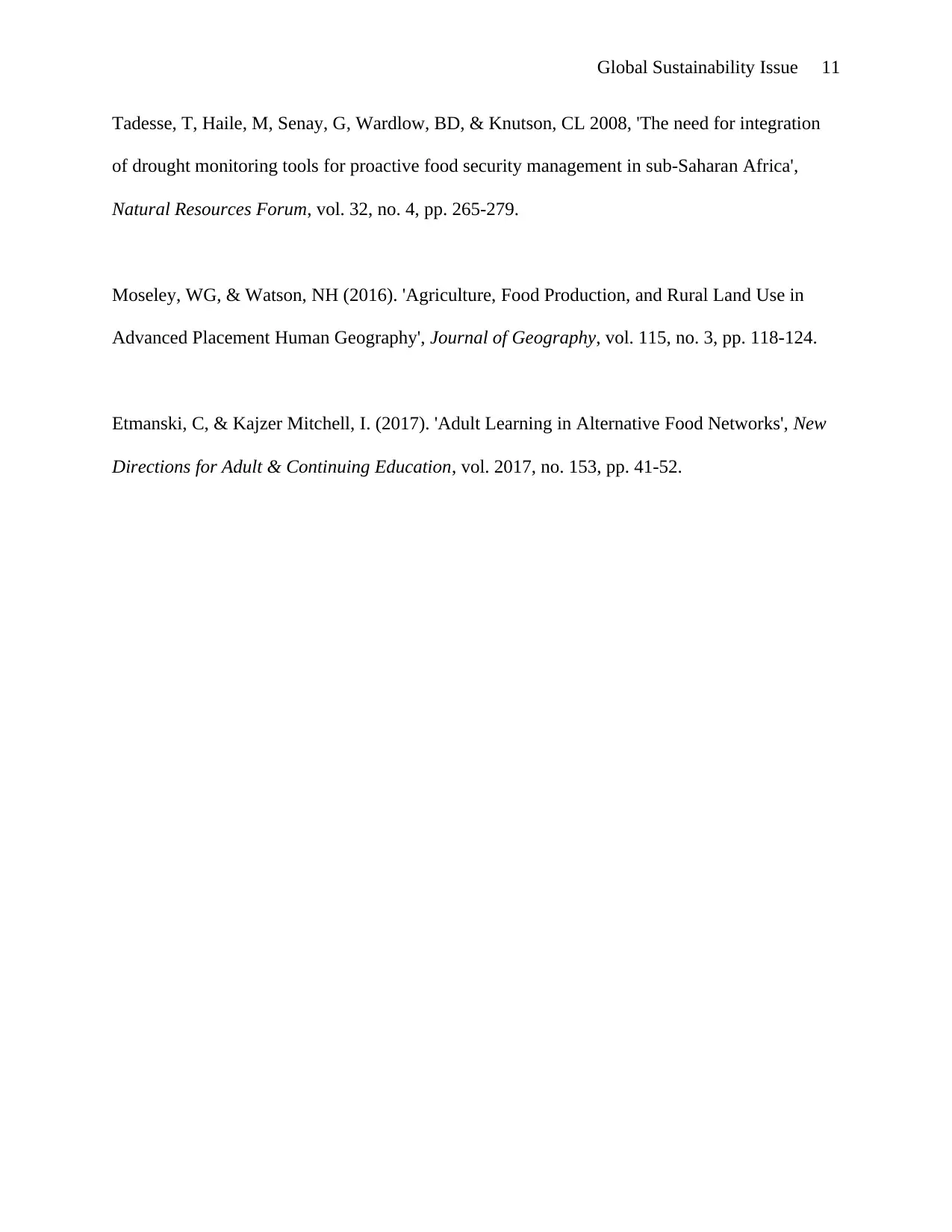
Global Sustainability Issue 11
Tadesse, T, Haile, M, Senay, G, Wardlow, BD, & Knutson, CL 2008, 'The need for integration
of drought monitoring tools for proactive food security management in sub-Saharan Africa',
Natural Resources Forum, vol. 32, no. 4, pp. 265-279.
Moseley, WG, & Watson, NH (2016). 'Agriculture, Food Production, and Rural Land Use in
Advanced Placement Human Geography', Journal of Geography, vol. 115, no. 3, pp. 118-124.
Etmanski, C, & Kajzer Mitchell, I. (2017). 'Adult Learning in Alternative Food Networks', New
Directions for Adult & Continuing Education, vol. 2017, no. 153, pp. 41-52.
Tadesse, T, Haile, M, Senay, G, Wardlow, BD, & Knutson, CL 2008, 'The need for integration
of drought monitoring tools for proactive food security management in sub-Saharan Africa',
Natural Resources Forum, vol. 32, no. 4, pp. 265-279.
Moseley, WG, & Watson, NH (2016). 'Agriculture, Food Production, and Rural Land Use in
Advanced Placement Human Geography', Journal of Geography, vol. 115, no. 3, pp. 118-124.
Etmanski, C, & Kajzer Mitchell, I. (2017). 'Adult Learning in Alternative Food Networks', New
Directions for Adult & Continuing Education, vol. 2017, no. 153, pp. 41-52.
1 out of 11
Related Documents
Your All-in-One AI-Powered Toolkit for Academic Success.
+13062052269
info@desklib.com
Available 24*7 on WhatsApp / Email
![[object Object]](/_next/static/media/star-bottom.7253800d.svg)
Unlock your academic potential
© 2024 | Zucol Services PVT LTD | All rights reserved.





